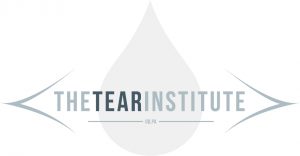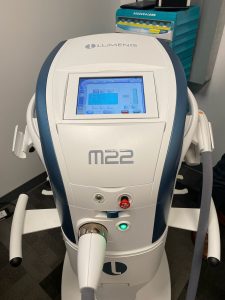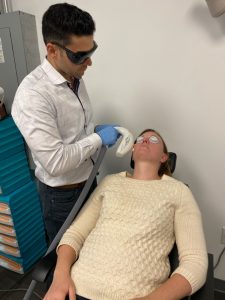
If your eyes feel gritty, tired and irritated more often than not, you may be plagued with a troublesome condition called dry eye. Our Tear Institute team uses state-of-the-art technology and treatment options to handle everyday dry eye to advanced cases of an ocular surface disease. Our team screens all patients for dry eye, even if they exhibit no symptoms so that no case of this progressive disease will go unseen.
If you are suffering from dry eye or have been diagnosed with an autoimmune disease, we encourage you to schedule an appointment with us for an in-depth dry eye examination.
The How and Why of Dry Eye
The eyes are sensitive organs that require both hydration and protection against outside threats. The meibomian glands and lacrimal glands address this need by working together to maintaining a constant tear film on the front of the eye. This film, which is refreshed every time you blink, is more than just water — it’s a three-layered barrier consisting of mucin, water and an outer covering of lipid to prevent evaporation. Any imbalances or deficiencies in the tear film can result in dry eye, whether you’re failing to produce one particular component or you’re simply not making enough tears.
Causes of dry eye may include:
• Age
• Immune system disorders such as Sjogren’s syndrome
• Eyelid dysfunction
• Trauma
• Atrophic meibomian glands
• Medications
• Constant exposure to moving air (ceiling fans, etc.)
• Long periods of computer use
Whatever the underlying reasons for your dry eye, don’t let it go untreated. Chronic dryness can cause redness, itching, irritation, blurred vision, foreign body sensation, extreme sensitivity to light and thick collections of mucus in or around the eyes. Ironically enough, you may also suffer from watery eyes as your lacrimal glands fight to maintain hydration. Even worse, your unprotected eyes may be especially prone to infections and other health threats, to the point that is permanently sight threatening.

Our Dry Eye Institute Exam includes:
- A tear film exam
- A test called Lipiview II Lipid Layer/Blink Imaging/Meibography – This test measures the thickness of the lipid layer of your tears, blinking patterns, and a structural image of your meibomian glands.
- A biomicroscopy of the eye surface with Vital Dyes
- Korb Meibomian Gland Evaluator Analysis
Lumenis IPL for Dry Eye and Other Eye Conditions
Dry eye, ocular rosacea, blepharitis, and other irritating eye conditions have been challenging to correct — until now. The team at The Eye Institute has a treatment for people who live with chronic dry eye, or itchiness caused by ocular rosacea.
Lumenis IPL (Intense Pulse Light) can help with redness, skin problems, and eye problems. This safe treatment uses light to target the skin.
How IPL Treats Eye Conditions
Arrive with a clean face (no makeup, moisturizer) at your appointment. Ultrasound gel well be applied to your face to to help make the procedure more efficient. Then, we gently press the cooled IPL applicator to your skin on a small rectangular area and project a beam of visible light, similar to laser treatment. IPL’s light releases in many different wavelengths, like a photo flash. This scattered light penetrates to the second layer of the skin without harming the top layer and is targeting the selected chromophore. For example when treating rosacea, the chromophore would be oxyhemoglobin.
We repeat this process, working our way across the face. The area of treatment depends on the issue we’re treating. For ocular rosacea and dry eye, we’ll move across your face from one side to the other and over the bridge of your nose.
The IPL can also be used to treat sunspots, telangiectasia (spider veins), and erythema (redness) around the eyes. Treated patients report a more youthful appearance afterward; results are immediate.
IPL Frequently Asked Questions

- Does it hurt? Some people report feeling a slight pinch, like plucking a hair.
- How do I prepare? There is no preparation needed except to arrive with a clean face, and there is no recovery time. Avoid direct sunlight and sunburns two weeks before as well as waxing, chemical peels, retinol, collagen injections, and creams or products that contain vitamin A.
- How much does IPL cost? The cost depends on what we are treating. Insurance does not typically cover the procedure. Contact us for a consultation so we can provide your exact cost.
The treatment is now available at our Seaboard Station location. If you think IPL might help you, ask your TEI doctor for more information.
The Tear Institute Can Solve Your Dry Eye Puzzle
Bring your dry eyes to our Advance Dry Eye Center. Our optometrists will ask you about your medical/medication history, your work habits, and your everyday environment. They will conduct an in-depth examination to determine what’s causing the problem.
Some treatments are eye drops, cleaners, and scrubs. Your optometrist will determine the best approach for your dry eye.
Some of Our Other Dry Eye Solutions
- Lumenis IPL
- Lipiflow Thermal Pulsation System
- Restasis/Xiidra Topical Intervention
- Punctal Occlusion
- Autologous Serum Eye Drops
- PRN Physician Recommended Nutriceuticals Dry Eye Omega Benefits
- Avenova Daily Lid and Lash Hygiene
- Prokera Biologic Corneal Bandage
- Ocusoft Advanced Lid Scrubs
- Cliradex All Natural Lash and Eyelid Cleaner
- TempSure™ Envi








